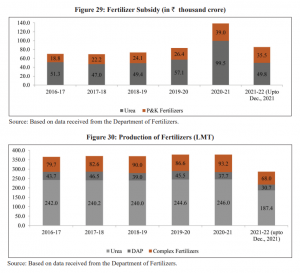
Amid the raging war between Russia and Ukraine, India is looking to reduce its fertilizer dependency on the former and has, for the first time, made a significant order of urea from the United States. The US has been an occasional supplier and most of India’s fertilizer imports have been from other countries. With the Russian invasion of Ukraine, the prices of fertilizers have shot up which could have meant an increased subsidy burden on the government. The decision to import urea from the US may not only be financially sensible, but is a diplomatically sound one. India’s subsidy bill stood at Rs 1.25 lakh crore last year and is expected to touch Rs 2 lakh crore this year.
The rising prices is just a part of the country’s larger fertilizer problem. Indian farmers’ tussle with the fertilizer sector runs quite deep and has been a sore point even before the beginning of the Ukraine conflict.
Need for fertilizer sector reforms
The calls for fertilizer reforms have been getting louder since the launch of economic reforms in 1991. Various governments have made attempts in this direction. There have been attempts to keep the fertilizer subsidy bill under check, promote efficient use of fertilizers, achieve balanced use of N, P and K (nitrogen, phosphorus and potassium), and reduce water and air pollution.

It is not that nothing has been achieved so far. Since 2014, important reforms have been implemented in the fertilizer sector such as neem-coating of urea which may have reduced the diversion of fertilizer meant for Indian farmers, and gas pooling to increase efficiency of domestic urea production. These efforts are beneficial not only to the government, but also helps small farmers by improving their access to low-cost fertilizer.
Also Read: Fertilizer policy 2021: Govt faces Hobson’s choice on price hikes
Woes in the fertilizer sector
India is not the only country which suffers due to high fertilizer prices — and the problem is not just about the prices. The countries that were earlier major exporters of fertilizers to India have now become buyers themselves as they have started to ramp up their stock in the wake of global uncertainties. This includes China which was once a major exporter to India. The problem of depleting urea stocks was also intensified by the fact that India entered the kharif season planting and demand for fertilizers shot up in May.
Meanwhile, India looks to become self-sustainable in the sector. The Union ministry of chemicals and fertilizers has already kickstarted the process of reviving five fertilizer plants in Gorakhpur (Uttar Pradesh), Barauni (Bihar) and Sindri (Jharkhand), Ramagundam (Telangana), and Angul (Odisha). For the time being, the government is likely to continue importing from the US in its bid to diversify import sources. The country imported 10.16 million tonnes of urea valued at $6.52 billion in 2021-22. The imports were chiefly from China (2.79 mt), Oman (1.62 mt), United Arab Emirates (1.06 mt), Egypt and Ukraine (0.75 mt each), Qatar (0.58 mt) and Saudi Arabia (0.50 mt).
The urea subsidy issue
Fertilizer accounts for large subsidies, second only to food. However, even after large government spending, only a small number of farmers are benefited. The problem with urea, however, is of underpricing it compared with other fertilizers.
There are three types of fertilizers used most widely by farmers — urea, diammonium phosphate (DAP), and muriate of potash (MOP). Urea, however, dominates the market and the urea industry is highly regulated, leading to black marketing of the nutrient. This burdens small farmers disproportionately, incentivizes production inefficiency, and leads to over-use. Apart from this, urea usage is also harming the environment by affecting soil quality and damaging human health.
Urea usage has many disadvantages. In most cases, the real utilization rate of urea’s nitrogen is only around 30%. Moreover, urea has high nitrogen content due to which it should not be used in access in order to avoid waste and fertilizer damage. In fruit-producing areas, use excess urea is connected with death of trees and has catastrophic implications. In terms of the environment, the production of urea involves the discharge of numerous toxic chemicals into the atmosphere. Furthermore, storage of urea needs excessive care as it is a volatile material that might explode if kept improperly or without monitoring. The fertilizer can also cause skin, eyes, and respiratory tract irritation.
Since the government highly subsidizes urea, its usage has soared while it will be more beneficial to both environment and farmers that the latter starts to use all available fertilizers in a balance. The time has come to seriously consider paying farmers a flat per-acre cash subsidy that they can use to purchase any fertilizer instead of giving them high subsidy on a single type. This is, perhaps, the only sustainable solution to prevent diversion of urea and also encourage judicious application of fertilizers, with the right nutrient (considering both macro and micro) combination based on proper soil testing and crop-specific requirements.
For now, what the government can do is to increase imports and increase domestic availability. What further needs to be done is to provide benefits directly to farmers and check urea diversion. The government may also look at setting up more plants in countries where the energy and importing prices are cheap with an aim to become self-sustaining in the coming future. Moreover, a shift to bio-fertilizers may also come in handy especially if environmental concerns are to be addressed. To do the same, the need is to spread awareness about bio-fertilizers which can be supplemented with chemical fertilizers.
